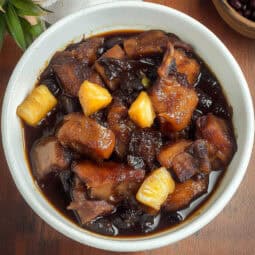
Visayan Pork Humba (with Pineapple & Banana Blossoms)
Humba is a Visayan braised pork dish that transforms humble belly cuts into fork-tender morsels through slow cooking in a complex sauce of soy, vinegar, and pineapple juice. Distinguished from adobo by its use of fermented black beans (tausi), dried banana blossoms, and a subtle sweetness, this heritage recipe balances rich, savory flavors with hints of fruit and umami. Each bite delivers melt-in-your-mouth meat swimming in a glossy, reduced sauce that begs to be spooned over hot rice.
Equipment
- Large heavy-bottom pot or Dutch oven (kaldero)
- Mixing bowl for marinating (mangkok)
- Sharp knife (kutsilyo)
- Measuring cups and spoons (Panukat)
- Wooden spoon (sandok na kahoy)
Ingredients
For the Meat and Marinade:
- 2 pounds pork belly liempo, cut into 1.5-inch cubes
- ¼ cup vinegar suka
- ½ cup soy sauce toyo
- 1 cup pineapple juice katas ng pinya
For Cooking:
- 1 tablespoon cooking oil mantika
- 1 medium onion sibuyas, finely sliced
- 6 cloves garlic bawang, minced
- 1 teaspoon whole peppercorns paminta
- 2 bay leaves dahon ng laurel
- 1 can 6 oz fermented black beans (tausi), rinsed and drained
- 1 cup pineapple chunks pinya
- 1 oz dried banana blossoms puso ng saging
- 1 tablespoon brown sugar asukal na pula
- Salt to taste asin
Instructions
- Begin by preparing your pork belly (liempo). Take your sharp knife (kutsilyo) and cut the meat into uniform cubes about 1.5 inches in size. Make sure your cuts are even to ensure consistent cooking. Take your fermented black beans (tausi) and rinse them thoroughly under cold running water to remove excess salt. Place your dried banana blossoms (puso ng saging) in a bowl of warm water at 35°C/95°F and let them soak for 15 minutes, then drain and set aside.
- Create your marinade by combining vinegar (suka), soy sauce (toyo), and pineapple juice (katas ng pinya) in a non-reactive mixing bowl (mangkok). Add your cubed pork belly to the marinade, making sure all pieces are well-coated. Place the bowl in the refrigerator set at 4°C/39°F and marinate for exactly 30 minutes - no longer, as the acid can start breaking down the meat too much.
- While the meat marinates, prepare your aromatics. Slice your onion (sibuyas) finely and mince your garlic (bawang). Set your stove to medium heat (175°C/350°F) and place your heavy-bottom pot or Dutch oven (kaldero) on the burner. Add your cooking oil (mantika) and let it heat up until it shimmers.
- Add your sliced onions to the hot oil and cook them until they become transparent and soft, about 2-3 minutes. Add your minced garlic and cook for another minute until you can smell its aroma. Remove your marinated pork from the refrigerator and drain it, but save the marinade - you'll need it later.
- Add your drained pork to the pot and cook until it develops a light brown color on all sides, about 5-7 minutes. Pour in your reserved marinade and bring the mixture to a boil. Once boiling, add your whole peppercorns (paminta) and bay leaves (dahon ng laurel).
- Now add your rinsed tausi, pineapple chunks (pinya), and the soaked banana blossoms to the pot. Reduce your heat to low (150°C/300°F) and cover the pot. Let everything simmer together, giving it a gentle stir every 20 minutes or so. The meat needs to cook slowly for about 1.5 to 2 hours until it becomes tender enough to cut with just your fork.
- After about an hour of cooking, add your brown sugar (asukal na pula). Continue cooking until the sauce has reduced and thickened - it should coat the back of your wooden spoon (sandok na kahoy). You'll know your humba is ready when you see clear oil pools forming on the surface, the meat easily falls apart when pressed, and the internal temperature of the meat reaches 90°C/195°F.
- Once done, remove the pot from heat and let your humba rest for 15 minutes. This resting time allows the meat to become even more tender and lets the flavors settle. Serve your humba hot over steaming white rice (kanin).
- For storing leftover humba, let it cool completely before transferring to an airtight container. It will keep in your refrigerator at 4°C/39°F for up to 4 days. When reheating, warm it gently on the stove over medium-low heat until it reaches 74°C/165°F throughout. Add a small amount of water if the sauce has become too thick.
- If you want to freeze your humba, place it in a freezer-safe container and store at -18°C/0°F for up to 2 months. When ready to eat, thaw overnight in the refrigerator before reheating using the method described above.
- Remember that humba tastes even better the next day, as the flavors continue to develop and deepen overnight. This makes it an excellent dish to prepare in advance for special occasions or family gatherings.
Tips from Lola's Kitchen
- Meat Selection: Choose pork belly with a good meat-to-fat ratio. Look for pieces with visible layers of fat and meat.
- Marination: Don't exceed 30 minutes of marination - the acid can make the meat mushy if left too long.
- Color Development: For a richer color, allow the sauce to reduce until it coats the back of a spoon.
- Banana Blossoms: Soak dried banana blossoms in warm water for 10 minutes before using to soften them.
- Oil Rendering: The dish is ready when you see little pools of clear oil forming on top.
Nutrition
Calories: 894kcalCarbohydrates: 19gProtein: 17gFat: 83gSaturated Fat: 29gPolyunsaturated Fat: 9gMonounsaturated Fat: 39gTrans Fat: 0.01gCholesterol: 109mgSodium: 1131mgPotassium: 456mgFiber: 1gSugar: 12gVitamin A: 43IUVitamin C: 9mgCalcium: 35mgIron: 2mg
Tried this recipe?Let us know how it was!